Winter is coming, so naturally, it’s time to start thinking about seaplanes… right? It always seems weird to write about water-based activities as frost begins to envelop the northern two-thirds of the country. Yet winter is when all the big boat shows happen because buying new vessels requires advance planning. It’s also pleasant to think about spring and summer while snow flurries fly.
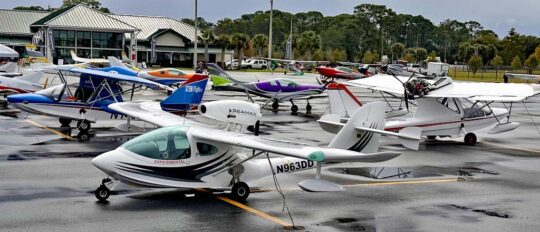 For many years I’ve written about this sector and names like Searey, Seamax, and Aventura (all in nearby image) have long been the leading brands. Now the first two are in financial trouble and the last has decamped to Brazil from Florida. Whatever is going on, Vickers Wave may represent a breath of fresh air.
For many years I’ve written about this sector and names like Searey, Seamax, and Aventura (all in nearby image) have long been the leading brands. Now the first two are in financial trouble and the last has decamped to Brazil from Florida. Whatever is going on, Vickers Wave may represent a breath of fresh air.
In articles last fall and this spring, I gave overviews of the entire LSA seaplane market (read here or here).
Vickers Wave Update
Vickers previously noted, “Wave has finished its flight testing, resulting in a 120-knot cruise and useful load of 750 pounds powered by a Rotax 916iS (reviewed here).”
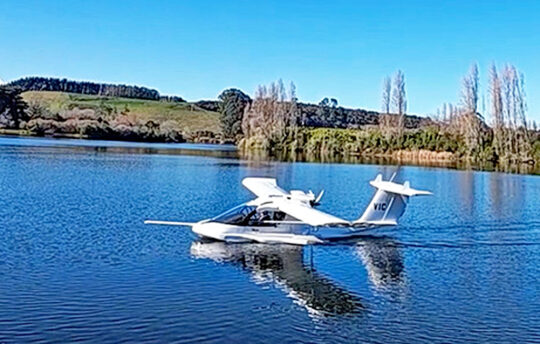 “A frequently asked question I receive is, ‘What is taking so long?’,” begins Paul Vickers. “Given the scale and complexity of a project like this, it’s worth explaining some of the key challenges we’ve faced and the strategies we’ve employed to address them.”
“A frequently asked question I receive is, ‘What is taking so long?’,” begins Paul Vickers. “Given the scale and complexity of a project like this, it’s worth explaining some of the key challenges we’ve faced and the strategies we’ve employed to address them.”
“The process of developing an aircraft like the Wave has spanned nearly 15 years (2009) — approximately one-third of my life,” Paul continued. “The path to this stage has been characterized by sustained focus and incremental progress.”
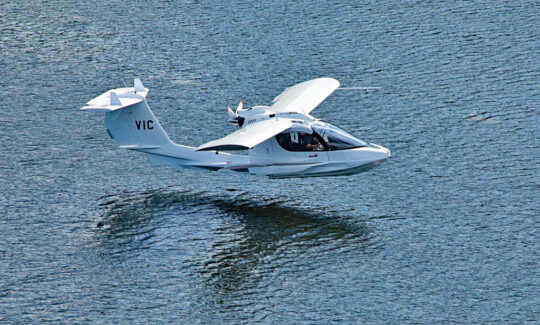 Recalling his early days, Paul wrote, “For the first three to four years, I was the only person dedicated full-time to the Wave, working six to seven days a week.” He was focused on ensuring the structural and aerodynamic integrity of the aircraft. Flight testing (report) validated Wave’s performance calculations.
Recalling his early days, Paul wrote, “For the first three to four years, I was the only person dedicated full-time to the Wave, working six to seven days a week.” He was focused on ensuring the structural and aerodynamic integrity of the aircraft. Flight testing (report) validated Wave’s performance calculations.
Seven years after beginning design work, in late 2016 Vickers began building operations. “This period marked our move to a larger facility and the start of assembling a dedicated team,” said Paul. “Building a skilled team that could effectively collaborate on this ambitious project was a gradual process.” Today, Team Vickers has grown to 20 people. “Despite a modest budget and a streamlined team, we have successfully moved from design to production of a fully operational aircraft,” Paul stated.
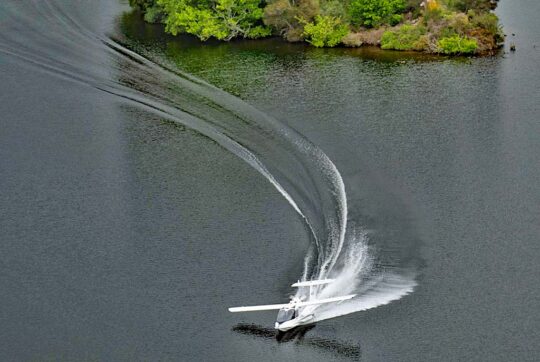
“Our approach from the beginning has been to construct the prototype with production tooling, molds, and processes,” clarified Paul. “This approach aims to reduce variability in future production stages, though it requires significant up-front investment in research and development, creating production-ready tooling, and composite-structure molds. Many manufacturers prioritize design at the expense of manufacturability, but we have chosen to focus on both, with an emphasis on building production efficiencies from the outset.”
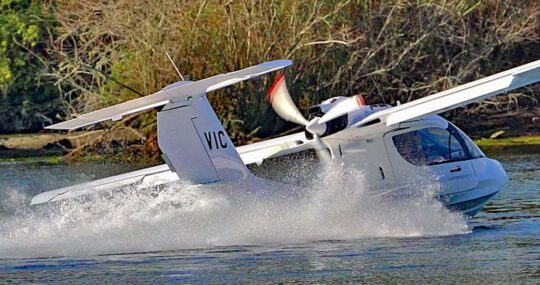
Each composite assembly undergoes rigorous testing. “We produce hundreds of test samples (coupons) in various weights and configurations, which are sent to certified labs,” began Paul. “These samples are then tested across a range of environmental conditions, including standard daily temperatures, elevated temperatures, hot and wet conditions, and extreme cold. This testing yields ‘material allowables’ which guide the design and size of components to ensure compliance with our structural requirements. We repeat these tests with various adhesives to validate bonding integrity under similar environmental stresses.”
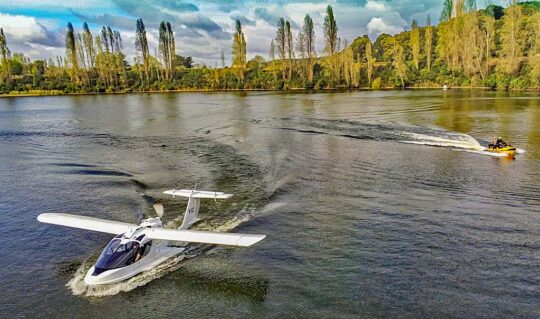
Getting Specific
Water Thruster Testing (nearby image) — “Our recent water tests of the Wave’s water thrusters were a resounding success,” boasted Paul. “The results showed excellent maneuverability, as well as impressive control and docking ease, underscoring the thrusters’ efficiency and responsiveness.” View a brief video below illustrating how these work.
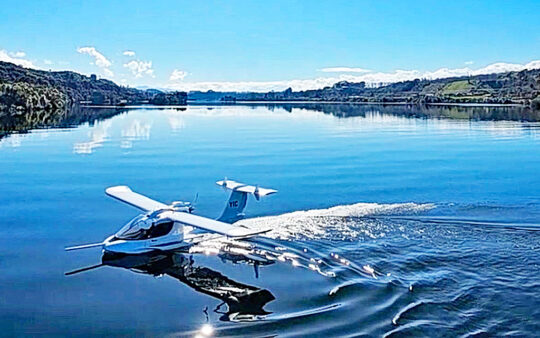
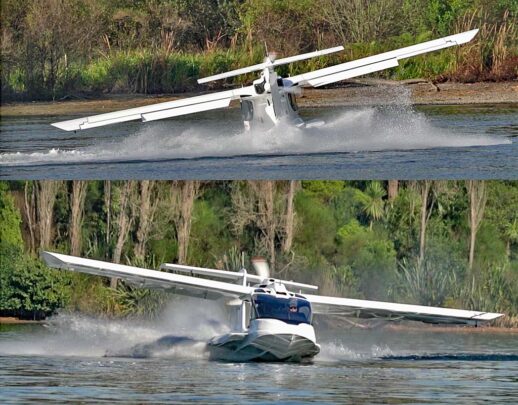
Some images in this article reflect earlier iterations of Wave. Those with vertical components on the horizontal stabilizer are the newest photos.
- Q1 2025: Initial U.S. sales and distribution location announcement
- Q2 2025: U.S.-based manufacturing location selection
- Post-Production First Flight: Opening of order book
Q&A with the Designer
When will the order book open? “Once we have completed production aircraft test flights and we have a fully accurate costing structure.”
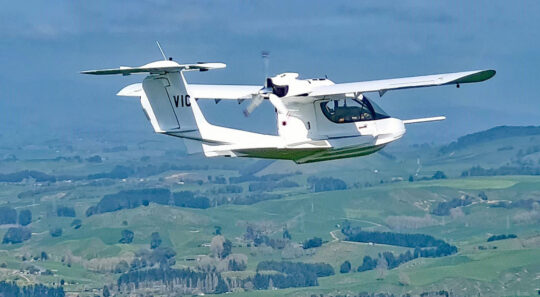
What is your current expected pricing? “We are keeping this quiet until we have manufactured the first few units; this way, when we announce the price we can stand by and honor it.”
Have you any more detailed specifications or information? “We are confident with 120-knot cruise, useful load of 750 pounds, and 1,100 nautical mile range. Automatic wing fold will operate on the water with engine running. Using thrusters for the first and last few hundred feet of water maneuvering supplies a very controllable and peaceful start and finish to your adventure.”
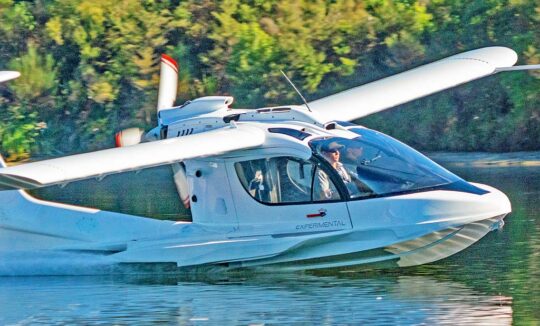
How will you gain approval for Wave? “Wave will also be offered not only as a current LSA and Mosaic LSA, but also as a Type Certified aircraft using the Primary category.”
“We have taken the time required to ensure Wave comes to market only when it’s ready, and we make no apologies for taking the time to get it right. Wave will be well worth the wait and will set a new bar for seaplane quality, functionality, and performance.”
—Thanks, Paul!
ARTICLE LINKS:
- Vickers Aircraft, company website
- All articles and contact info here on ByDanJohnson.com
This company video shows testing of the water thrusters on Wave. Note how tightly it can turn on the water.



Thrusters are really nice idea. Video shows great control and maneuverability in calm winds. Have they been tested on a windy day and do they offer equal results?
By all means, pose your question to Vickers Aircraft.
I completely agree with Paul’s statements about when the aircraft will be ready for official release/sale.
I think it is better to make sure everything works as advertised, and to know what actual costs and profitability percentages are before selling a product.
Too often in our “I want it right now” society there is misleading performance advertised, cost changes and the like.
I was once told “Do you want it right, or right now?” Now this was related to design and engineering, but I believe it applies to advertised products as well.
I apologize for the long comment as well.
The Vickers Seaplane looks awesome!
Dan, it is great to see reports from you again too!
Thanks for your comment. I may have retired but I haven’t left the industry. Look for more throughout 2025.
Nice article update here but could not open the attached water thruster demo video.
Hmmm…? It works fine for me. Perhaps refresh the page? Otherwise, try this link.
What is the Wave’s max gross weight? Will it have different weights for different certification categories?
You might have missed the in-article link regarding weight but here it is: Wave’s Weight Exemption (MTOW of 1,850 pounds or 839 kilograms).
As to changes for a Mosaic LSA version or one qualifying under Primary Category, those details will have to wait a while longer.
Thanks. That answers a lot.